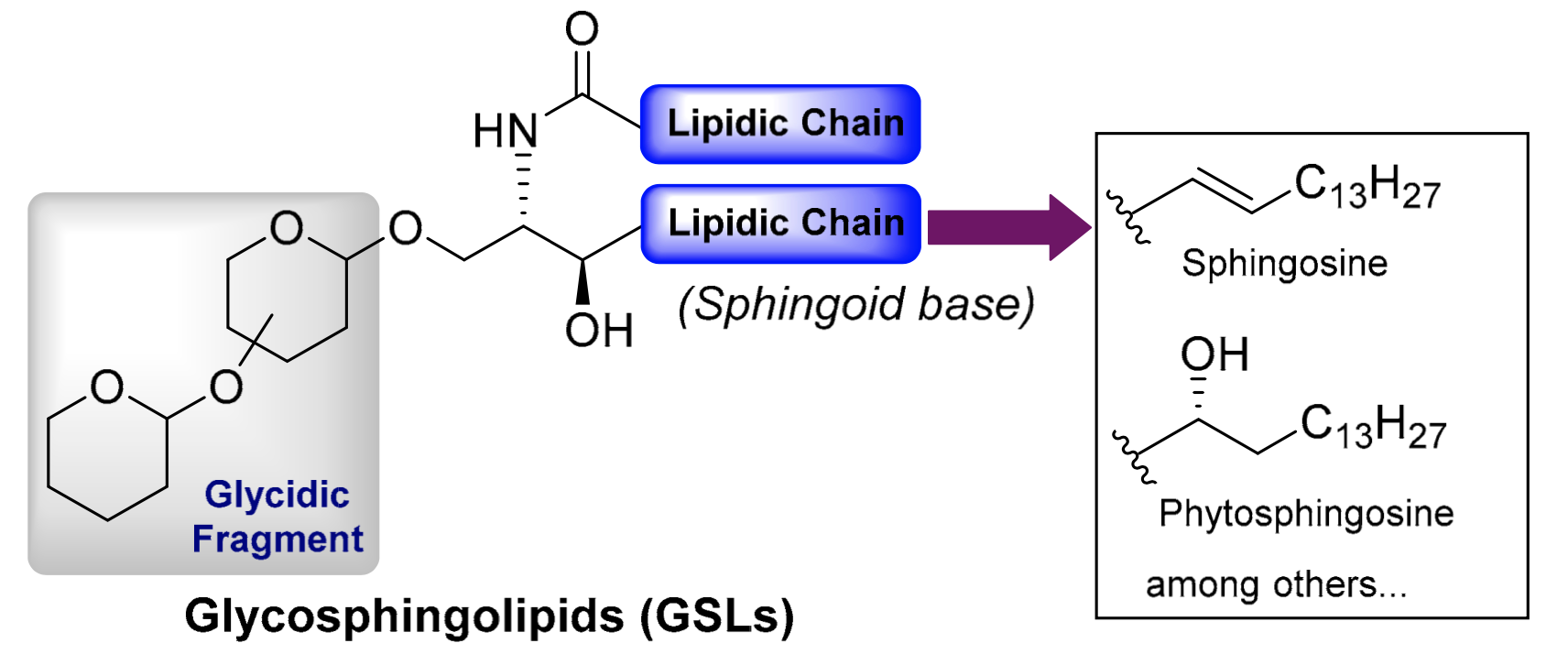
GLYCOSPHINGOLIPIDS
There is a considerable variation in this group of glycosphingolipids which are extensively found in all living beings. More than 150 varieties are known, about 50 of them being classified into the ganglio structure. Distributed mainly at the surface of the cell, they participate in many ways to the regulation of the interactions of cells with their environment. These lipids serve as distinguishing markers for cells and mediate cell-to-cell recognition and communication (see Review article on sphingolipid functions). They are essential for the development and growth of organisms and have been implicated in a number of serious diseases (cancer, viral or microbial infections).
The vast range of head group structures found on the cell surface suggest that they function in specific recognition between cells and in signaling towards the cell interior forming molecular complex named “glycosynapse” (Hakomori SI, PNAS 2002, 99, 225).

General structural feature of glycosphingolipids
(from: Cheng-Sánchez I et al., Mar Drugs 2018, 16, 294)
An extensive review of these glycosphingolipids found in bacteria, fungi, plants, and animals was written by Tan RX et al. (Nat Prod Rep 2003, 20, 509). A review on the cell biology of glycosphingolipids (synthesis, traffic, sorting and functions) may also be found (Degroote S et al., Sem Cell Develop Biol 2004, 15, 375). A review includes data concerning chemical structures of sphingolipids from two classes of the phylum Echinodermata and their biological activities and covers the literature from 2000 to 2021 (Malyarenko TV et al., Mar Drugs 2021, 19, 330). Authors indicated that echinoderms and, in particular, starfish and sea cucumbers are a rich source of sphingolipids, structures of which may differ markedly from the corresponding metabolites of plants and terrestrial animals. Chemistry and biology of bioactive glycolipids of marine origin have been extensively examined (Cheng-Sánchez I et al., Mar Drugs 2018, 16, 294). In different starfish species, acanthacerebrosides and astrocerebrosides represent interesting members of glycosphingolipids. Within the family of phytosphingosine-containing cerebrosides present in sponges, the agelasphins occupy a privileged position by virtue of their striking and promising biological properties. Several other types of glycosphingolipids have been isolated from marine sponges, sea cucumbers, ascidians, and starfishes.
The separation of glycosphingolipids into groups and subgroups is made according to the structure of the carbohydrate moiety but they show also great variations in the acyl moiety as well as in the sphingosine moiety. The nomenclature is somewhat confusing and for several compounds there are also historical trivial names.
The last IUPAC recommendations for the nomenclature of glycolipids may be found on the IUPAC site.
The glycosphingolipids have been divided commonly into two main groups:
– Neutral glycosphingolipids (unsubstituted glycosyl group)
– Acidic glycosphingolipids (zwitterionic molecules : glycosyl group with carboxyl, sulfate or phosphate group)
![]()
A – The neutral glycosphingolipids
They may contain one or more glycosyl moieties, hexoses but eventually plus an additional hexosamine. A pentose has also been described.
According to the number of glycosyl units they are divided into:
– monoglycosylceramides (one glycosyl unit)
– oligoglycosylceramides (more than one glycosyl unit)
Other forms have been described :
– deacylated glycosphingolipids (only one glycosylated sphingoid base)
– plakosides (complex sphingolipids with a ceramide containing a cyclopropane chain and prenylated residues on galactose)
B – The acidic glycosylceramides
They may be divided into:
– sulfosphingolipides (sulfatides, ceramide di- and tri-hexosyl sulfate with one sulfate group on the glycosyl unit)
– phosphosphingolipids (phosphorylceramide with glycosyl or oligosaccharide head group)
– acidic monoglycosylceramides
– gangliosides (the most complex, contain a carboxyl group on sialic acid and several glysosyl residues)
DISPERSIVE LIQUID-LIQUID MICROEXTRACTION
Lire la suiteDevenez membre et participez au développement de la Lipidomique au XXIème siècle.
S'inscrire